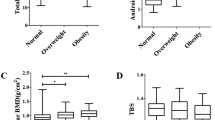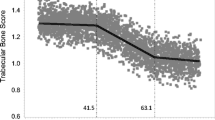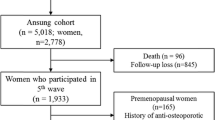Abstract
Summary
This study examines demographic patterns and body size relationships in trabecular bone score and lumbar spine BMD of US adults from NHANES 2005–2008.
Introduction
Limited data exist on demographic and body size relationships for trabecular bone score (TBS), a new variable derived from bone texture analysis of lumbar spine dual-energy X-ray absorptiometry (DXA) scans. This study compares demographic patterns and correlations with body size (body mass index (BMI), weight, waist circumference, total body fat, trunk fat, trunk lean) between TBS and lumbar spine bone mineral density (LSBMD) for adults age ≥20 years from the National Health and Nutrition Examination Survey (NHANES) 2005–2008 with BMI in the optimal range for TBS (15–37 kg/m2).
Methods
LSBMD, TBS, body fat, and lean were obtained by DXA. Weight, height, and waist circumference were measured. BMI was calculated from height and weight.
Results
Sex differences in TBS varied by age and race/ethnicity (p sex X age interaction and p sex X race/ethnicity interaction < 0.001). In most of the nine demographic subgroups examined, TBS did not differ by sex (four subgroups) or was significantly higher in women (three subgroups). TBS differences by race/ethnicity were inconsistent in men; in women, non-Hispanic whites (NHWs) had higher TBS than non-Hispanic blacks (NHBs) or Mexican Americans (MAs) in all age groups. In contrast, LSBMD was either significantly higher in men (five subgroups) or did not differ by sex (four subgroups). Race/ethnic differences in LSBMD were consistent across age and sex (NHB > NHW > MA). All body size variables were negatively related to TBS but positively related to LSBMD.
Conclusions
Demographic patterns and body size relationships differed between TBS and LSBMD.


Similar content being viewed by others
References
Silva BC, Leslie WD, Resch H, Lamy O, Lesnyak O, Binkley N, McCloskey EV, Kanis JA, Bilezikian JP (2014) Trabecular bone score: a noninvasive analytical method based upon the DXA image. J Bone Miner Res 29:518–530
McCloskey EV, Oden A, Harvey NC, Leslie WD, Hans D, Johansson H, Kanis JA (2015) Adjusting fracture probability by trabecular bone score. Calcif Tissue Int 96:500–509
Silva BC, Broy SB, Boutroy S, Schousboe JT, Shepherd JA, Leslie WD (2015) Fracture risk prediction by non-BMD DXA measures: the 2015 ISCD official positions part 2: trabecular bone score. J Clin Densitom 18:309–330
Zipf G, Chiappa M, Porter KS, Ostchega Y, Lewis BG, Dostal J. (2013) National Health and Nutrition Examination Survey: plan and operations, 1999–2010. National Center for Health Statistics, Hyattsville, MD
Schousboe JT, Shepherd JA, Bilezikian JP, Baim S (2013) Executive summary of the 2013 International Society for Clinical Densitometry position development conference on bone densitometry. J Clin Densitom 16:455–466
Centers for Disease Control and Prevention National Center for Health Statistics (2007) Dual energy X-Ray absorptiometry (DXA) procedures manual. Centers for Disease Control and Prevention, National Center for Health Statistics. http://www.cdc.gov/nchs/data/nhanes/nhanes_07_08/manual_dexa.pdf
Centers for Disease Control and Prevention National Center for Health Statistics (2000) Anthropometry procedures manual. Centers for Disease Control and Prevention National Center for Health Statistics, Hyattsville MD
Centers for Disease Control and Prevention National Center for Health Statistics (2004) Body composition procedure manual. Centers for Disease Control and Prevention, National Center for Health Statistics. http://www.cdc.gov/nchs/data/nhanes/nhanes_03_04/bc.pdf
Centers for Disease Control and Prevention National Center for Health Statistics (2008) Technical documentation for the 1999–2004 dual-energy x-ray absorptiometry (DXA) multiple imputation data files. . http://www.cdc.gov/nchs/data/nhanes/dxa/dxa_techdoc.pdf
Seeman E, Delmas PD (2006) Bone quality—the material and structural basis of bone strength and fragility. New Engl J Med 354:2250–2261
Taylor AJ, Gary LC, Arora T et al (2011) Clinical and demographic factors associated with fractures among older Americans. Osteoporosis Int 22:1263–1274
Jacobsen SJ, Cooper C, Gottlieb MS, Goldberg J, Yahnke DP, Melton LJ (1992) Hospitalization with vertebral fracture among the aged—a national population-based study, 1986–1989. Epidemiology 3:515–518
Tracy JK, Meyer W, Grigoryan M, Fan B, Flores R, Genant H, Resnik C, Hochberg M (2006) Racial differences in the prevalence of vertebral fractures in older men: the Baltimore Men’s Osteoporosis Study. Osteoporosis Int 17:99–104
Cauley JA, Palermo L, Voot M, Ensrud KE, Ewing S, Hochberg M, Nevitt MC, Black DM (2008) Prevalent vertebral fractures in black women and white women. J Bone Miner Res 23:1458–1467
O’Neill TW, McCloskey EV, Kanis JA, Bhalla AK, Reeve J, Reid DM, Todd C, Woolf AD, Silman AJ (1999) The distribution, determinants, and clinical correlates of vertebral osteophytosis: a population based survey. J Rheumatol 26:842–848
Kolta S, Briot K, Fechtenbaum J, Paternotte S, Armbrecht G, Felsenberg D, Glüer CC, Eastell R, Roux C (2014) TBS result is not affected by lumbar spine osteoarthritis. Osteoporosis Int 25:1759–1764
Orwoll ES, Oviatt SK, Mann T (1990) The impact of osteophytic and vascular calcifications on vertebral mineral density measurements in men. J Clin Endocrinol Metab 70:1202–1207
Yu W, Gluer CC, Fuerst T, Grampp S, Li J, Lu Y, Genant HK (1995) Influence of degenerative joint disease on spinal bone mineral measurements in postmenopausal women. Calcif Tissue Int 57:169–174
Rand T, Seidl G, Kainberger F, Resch A, Hittmair K, Schneider B, Gluer CC, Imhof H (1997) Impact of spinal degenerative changes on the evaluation of bone mineral density with dual energy X-ray absorptiometry (DXA). Calcif Tissue Int 60:430–433
Borrud LG, Flegal KM, Looker AC, Everhart JE, Harris TB, Shepherd JA (2010) Body composition data for individuals 8 years of age and older: US population, 1999–2004. Vital Health Stat 11:1–87
Nevitt MC, Cummings SR, Stone KL et al (2005) Risk factors for a first-incident radiographic vertebral fracture in women ≥65 years of age: the Study of Osteoporotic Fractures. J Bone Miner Res 20:131–140
Compston JE, Flahive J, Hosmer DW et al (2014) Relationship of weight, height, and body mass index with fracture risk at different sites in postmenopausal women: the Global Longitudinal study of Osteoporosis in Women (GLOW). J Bone Miner Res 29:487–493
Roy DK, O’Neill TW, Finn JD et al (2003) Determinants of incident vertebral fracture in men and women: results from the European Prospective Osteoporosis Study (EPOS). Osteoporos Int 14:19–26
Samelson EJ, Hannan MT, Zhang Y, Genant HK, Felson DT, Kiel DP (2006) Incidence and risk factors for vertebral fracture in women and men: 25-year follow-up results from the population-based Framingham study. J Bone Miner Res 21:1207–1214
Johnell O, O’Neill T, Felsenberg D, Kanis J, Cooper C, Silman AJ (1997) Anthropometric measurements and vertebral deformities. European Vertebral Osteoporosis Study (EVOS) Group. Am J Epidemiol 146:287–293
Melton LJ 3rd, Atkinson EJ, Khosla S, O’Fallon WM, Riggs BL (1999) Secondary osteoporosis and the risk of vertebral deformities in women. Bone 24:49–55
Holmberg AH, Johnell O, Nilsson PM, Nilsson J, Berglund G, Akesson K (2006) Risk factors for fragility fracture in middle age. A prospective population-based study of 33,000 men and women. Osteoporos Int 17:1065–1077
Tanaka S, Kuroda T, Saito M, Shiraki M (2013) Overweight/obesity and underweight are both risk factors for osteoporotic fractures at different sites in Japanese postmenopausal women. Osteoporos Int 24:69–76
Laslett LL, Just Nee Foley SJ, Quinn SJ, Winzenberg TM, Jones G (2012) Excess body fat is associated with higher risk of vertebral deformities in older women but not in men: a cross-sectional study. Osteoporos Int 23:67–74
Pirro M, Fabbriciani G, Leli C, Callarelli L, Manfredelli MR, Fioroni C, Mannarino MR, Scarponi AM, Mannarino E (2010) High weight or body mass index increase the risk of vertebral fractures in postmenopausal osteoporotic women. J Bone Miner Metab 28:88–93
Gallagher D, Visser M, Sepúlveda D, Pierson RN, Harris T, Heymsfield SB (1996) How useful is body mass index for comparison of body fatness across age, sex, and ethnic groups? Am J Epidemiol 143:228–239
Flegal KM, Shepherd JA, Looker AC, Graubard BI, Borrud LG, Ogden CL, Harris TB, Everhart JE, Schenker N (2009) Comparisons of percentage body fat, body mass index, waist circumference, and waist-stature ratio in adults. Am J Clin Nutr 89:500–508
Fernández JR, Heo M, Heymsfield SB, Pierson RN, Pi-Sunyer FX, Wang ZM, Wang J, Hayes M, Allison DB, Gallagher D (2003) Is percentage body fat differentially related to body mass index in Hispanic Americans, African Americans, and European Americans? Am J Clin Nutr 77:71–75
Deurenberg P, Yap M, van Staveren WA (1998) Body mass index and percent body fat: a meta analysis among different ethnic groups. International journal of obesity and related metabolic disorders : journal of the International Association for the Study of Obesity 22:1164–1171
Camhi SM, Bray GA, Bouchard C, Greenway FL, Johnson WD, Newton RL, Ravussin E, Ryan DH, Smith SR, Katzmarzyk PT (2011) The relationship of waist circumference and BMI to visceral, subcutaneous, and total body fat: sex and race differences. Obesity (Silver Spring, Md) 19:402–408
Carroll JF, Chiapa AL, Rodriquez M, Phelps DR, Cardarelli KM, Vishwanatha JK, Bae S, Cardarelli R (2008) Visceral fat, waist circumference, and BMI: impact of race/ethnicity. Obesity (Silver Spring, Md) 16:600–607
Leslie W WR, Majumdar S, Lix L, Hans D (2014) Clinical performance of an updated version of trabecular bone score in men and women: the Manitoba BMD Cohort. J Bone Miner Res 29 (Suppl 1):
Leib E, Winzenrieth R, Aubry-Rozier B, Hans D (2014) Vertebral microarchitecture and fragility fracture in men: a TBS study. Bone 62:51–55
Aloia JF, Mikhail M, Usera G, Dhaliwal R, Islam S (2015) Trabecular bone score (TBS) in postmenopausal African American women. Osteoporosis Int 26:1155–1161
Leslie WD, Krieg MA, Hans D (2013) Clinical factors associated with trabecular bone score. J Clin Densitom 16:374–379
Iki M, Tamaki J, Sato Y, Winzenrieth R, Kagamimori S, Kagawa Y, Yoneshima H (2015) Age-related normative values of trabecular bone score (TBS) for Japanese women: the Japanese Population-based Osteoporosis (JPOS) study. Osteoporosis Int 26:245–252
Dufour R, Winzenrieth R, Heraud A, Hans D, Mehsen N (2013) Generation and validation of a normative, age-specific reference curve for lumbar spine trabecular bone score (TBS) in French women. Osteoporosis Int 24:2837–2846
Simonelli C, Leib E, Mossman N, Winzenrieth R, Hans D, McClung M (2014) Creation of an age-adjusted, dual-energy x-ray absorptiometry-derived trabecular bone score curve for the lumbar spine in non-Hispanic US White women. J Clin Densitom 17:314–319
Centers for Disease Control and Prevention National Center for Health Statistics (2010) 2005–2008 Data documentation, codebook, and frequencies: dual-energy X-ray absorptiometry -- Spine (DXXSPN_D). http://wwwn.cdc.gov/Nchs/Nhanes/2005-2006/DXXSPN_D.htm, http://wwwn.cdc.gov/Nchs/Nhanes/2007-2008/DXXSPN_E.htm
Zimmerman SI, Girman CJ, Buie VC, Chandler J, Hawkes W, Martin A, Holder L, Hebel JR, Sloane PD, Magaziner J (1999) The prevalence of osteoporosis in nursing home residents. Osteoporos Int 9:151–157
Author information
Authors and Affiliations
Corresponding author
Ethics declarations
All procedures in NHANES 2005–2008 were approved by the NCHS Research Ethics Review Board, and written informed consent was obtained from all subjects.
Conflicts of interest
None.
Required disclaimer
The findings and conclusions in this report are those of the authors and not necessarily those of the Centers for Disease Control and Prevention.
Rights and permissions
About this article
Cite this article
Looker, A.C., Sarafrazi Isfahani, N., Fan, B. et al. Trabecular bone scores and lumbar spine bone mineral density of US adults: comparison of relationships with demographic and body size variables. Osteoporos Int 27, 2467–2475 (2016). https://doi.org/10.1007/s00198-016-3550-6
Received:
Accepted:
Published:
Issue Date:
DOI: https://doi.org/10.1007/s00198-016-3550-6




